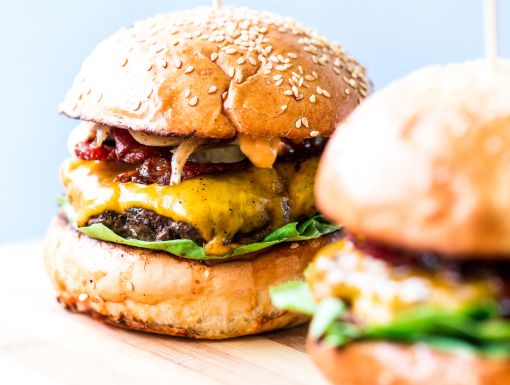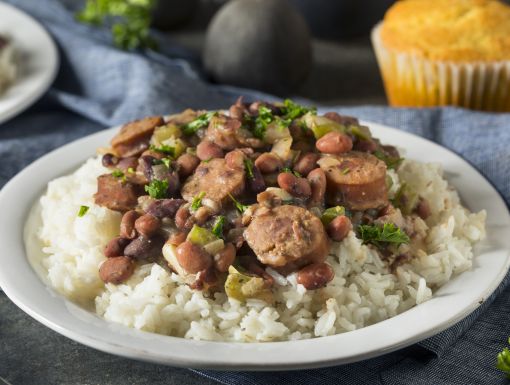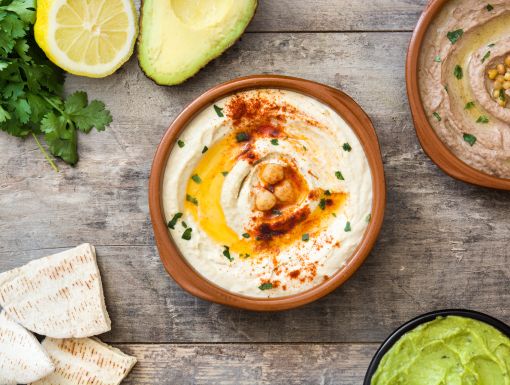
9 Creative Ways to Eat Meatless (or Meat Less)
As more of us try to cut back on meat or eliminate it from our diet altogether, we look to non-meat ingredients to get our protein. To keep things fresh, fun and easy, here’s a rundown of nine ways to get creative with non-meat ingredients as the main attraction.
9 Creative Ways to Use Non-Meat Ingredients
Protein-Rich Pasta. If you haven’t tried chickpea pasta (like Banza pasta) yet, you’ve got to try it to believe it. It looks and tastes like conventional pasta, yet packs 14 grams of protein into every 2-ounce serving – that’s the protein equivalent of about 2 ounces of meat. As an added bonus, it has 8 grams of fiber per serving. Beyond Banza chickpea pasta, you can also try black bean or edamame pasta; each has 25 grams of protein and 12 grams fiber per serving. Lentil pasta is also a crowd pleaser, with 14 grams protein and 3 grams fiber per serving. Looking for inspiration? Check out these easy-peasy recipes for Protein-Rich Pasta Salad, 3 Ways.
It’s all Greek (Yogurt). From smoothies to sauces to dips, Greek yogurt is a versatile way to add a boost of protein to any meal or snack. Look for brands with no added sugar. And keep in mind that low-fat (not fat-free) will typically work best in recipes. My favorite: Fage 2% plain Greek yogurt.
Tuna (or Salmon) Salad, 3 ways. Stocking up on cans of tuna but not sure just what to do with it? We’ve got you covered with this Eat Fit-approved recipe. TIP: For a lower-mercury tuna, opt for light tuna (versus albacore or white tuna). And mix things up with canned or pouch salmon as well – it’s higher in omega-3’s with less mercury than tuna.
Eggs. They’re relatively inexpensive, they’re an excellent source of protein and they’re also one of the top food sources of choline, which plays a key role in our metabolism. There’s the obvious: scrambled, omelet, frittata. Search online for “egg in a mug” and you’ll find hundreds of recipes for microwave-easy egg dishes. Add eggs to stir-fry dishes or mix in leftover vegetables and pour into a muffin tin for grab-and-go protein-rich egg muffins.
Beans. They’re incredibly cheap and they’re nutrient-rich, packing in a punch of protein, fiber and antioxidants. Serve them up over brown rice or cauliflower rice. Add to a stew or soup. Puree and add spices with a drizzle of olive oil for a new take on hummus. And check out our blog post, for six ways to use canned beans to create splurge-worthy indulgences from ice cream and cookies to red velvet cupcakes.
Crawfish. We don’t exactly associate crawfish with “health food,” but crawfish are surprisingly more nutritious than you might think. They’re low in calories – ounce-for-ounce, about 50% fewer calories than roasted, skinless chicken breast, in fact. They’re low in carbs and protein-rich, with zero saturated fat. They’re also an excellent source of vitamin B12 and selenium.
Boiled crawfish, of course, is typically very high in sodium, but crawfish naturally, is not. Buying frozen tails (just be sure they’re local) is one way to have crawfish that’s lower in sodium. Or buy crawfish boil seasoning blends that are spice blends only, and just add about one-quarter of the salt called for in the directions.
Add flavor, sans the meat. With a little creativity, it’s still possible to add in layers of flavor to traditional meat-centric dishes, without the traditional pickled, cured and smoked meats. It starts with cooking down onions, bell pepper and celery. Use low sodium vegetable stock when recipes call for water. Depending on the dish, grill, marinate or smoke vegetables to bring out their natural earthy flavors. And don’t forget a touch of acid (think vinegar or citrus), and of course, fresh herbs.
Smoked Tofu. You can find it already “smoked” in some stores, or you can do it yourself. Take a perforated stove top pan that fits inside deeper pan, add a few soaked wood chips into the bottom, and light the wood chips until they start to smoke. Add a few blocks of firm tofu to the top of the perforated pan and cover with foil for about 10 minutes or so. Tip: You may need to take it outside if it starts to get too smoky.
Eggplant and Mushrooms. In addition to the veggie-based meat replacers below, mushrooms and eggplant have a nice “meaty” texture. Each can be pureed and added to a dish for creaminess, or roasted, grilled or sautéed into a dish. Think eggplant lasagna, cubed eggplant and mushrooms added to soups, stews and casseroles, or grilled portobello mushroom burgers.
How to Select Meat Alternatives
Options for meat alternatives extend far beyond veggie burgers these days, with brands like Beyond, Impossible, Boca, Morningstar Farms, Yves and Tofurky making Italian sausage, “chicken” strips, faux bacon and sliced “turkey” as well as breakfast sausage links and patties.
To schedule a nutrition consult, whether virtually or in-person, contact us at nutrition@ochsner.org or call us at 504-733-1600.
The key is to read labels closely, as some brands have far more carbs and sodium than others. When looking for a product to serve as a meat replacer, compare the ratio of protein to carbs. As a general rule of thumb, I recommend to look for 2 to 3 times more protein than carbs (many brands have three times more carbs than protein). Some brands are loaded with vegetables but are still low in protein.
Here are some plant-based alternatives to meat for traditional recipes.
Italian Sausage Alternative
Top pick: Tofurky Original Italian Sausage | Vegan
· Good for: Red beans and rice, gumbo, jambalaya
· Ingredients include pea protein, expeller-pressed canola oil, rice flour, spice, tomato powder
· Nutrition Facts per 4 ounce serving: 180 calories, 6 grams fat, 0 saturated fat, 280 mg sodium, 2 grams carbohydrate, <1 gram fiber, 0 sugar, 14 grams protein
Ground Beef or Burger Alternative
Top pick: Beyond Meat | Vegan & Soy-Free
· Good for: Burgers, stuffed peppers, meat sauce.
· Ingredients include pea protein, canola oil, coconut oil, rice protein, cocoa butter, mung bean protein, methylcellulose, potato starch, beet juice extract for color.
· Nutrition Facts per 4-ounce serving: 260 calories, 18 grams fat, 5 grams saturated fat, 350 mg sodium, 5 grams carbohydrate, 2 grams fiber, 0 sugar, 20 grams protein.
Sliced Deli Meats
Top Pick: Lightlife Plant-Based Deli slices
· Good for turkey poboys, muffulettas, and eggs Benedict
· Ingredients include: Wheat gluten, navy bean flour, oil, garlic, kale, wheat flour, potato starch. Note: This product, like many of the “veggie deli meats,” is made with wheat gluten and added starches. But at least it also has navy bean flour and a dab of kale.
· Per 3 slices: 90 calories, 3 grams fat, 0 saturated fat, 340 mg sodium, 7 grams carbohydrate, 2 grams fiber, 1 gram sugar, 11 grams protein
Seitan
Top Pick: Franklin Farms (cubed, strips, ground)
· Good for stir-fry, soups, stews, roasted or pan-fried dishes
· Ingredients include vital wheat gluten, soy sauce, garbanzo bean flour and defatted soy flour. Note: Seitan has an excellent protein-to-carbohydrate ratio, but gluten is the primary source of protein.
· Per 3 ounce serving: 120 calories, 2 grams fat, 0 saturated fat, 320 mg sodium, 4 grams carbohydrate, 1 gram fiber, 2 grams sugar, 21 grams protein
Tofu
Top Pick: Brands are pretty equivalent; we don't have a top pick in this category. Options range from silken to firm to extra-firm tofu.
· Good for adding creaminess to dishes, or in place of meat or cheese like fresh mozzarella
· Per half-cup serving: 95 calories, 6 grams fat, less than 1 gram saturated fat, 10 mg sodium, 2.5 grams carbohydrate, 0.5 grams fiber, 10 grams protein
· Ingredients: Most contain water, whole soybeans, nigari (sea water extract) and calcium sulfate
Molly Kimball, RD, CSSD is a registered dietitian + nutrition journalist in New Orleans, and founder of Ochsner’s Eat Fit nonprofit initiative. Tune in to her podcast, FUELED | Wellness + Nutrition and follow her on Facebook, Instagram and Twitter at @MollyKimballRD. See more of Molly’s columns + TV segments at www.mollykimball.com.



